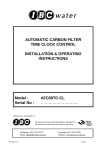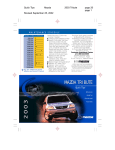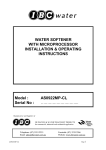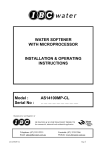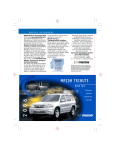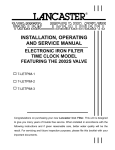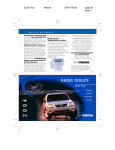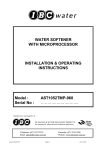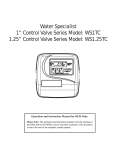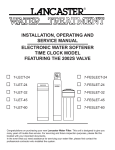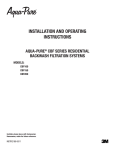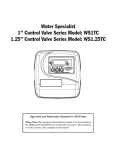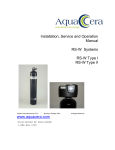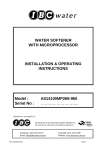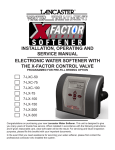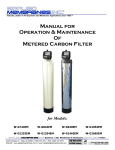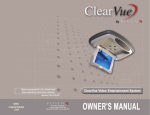Download AFM12TC-CL - IBC Water
Transcript
AUTOMATIC MULTI MEDIA FILTER TIME CLOCK CONTROL INSTALLATION & OPERATING INSTRUCTIONS Model : Serial No : AFM12TC-CL ……………………….. Manufacturer and Supplier of FILTRATION & WATER TREATMENT PRODUCTS for commercial, industrial and residential application Telephone: (07) 3219 2233 Email: [email protected] AFM12TC-CL Facsimile: (07) 3219 2266 Website: www.ibcwater.com.au Page 1 GENERAL WATER FILTER PERFORMANCE DATA SHEET Time Clock Model No. AFM12TC-CL Service Flow Rate Backwash Flow Rate Flow LPM Flow LPM 55 42 Pipe Size Approx. Shipping Weight (kg) Space Required Inlet Outlet Drain mm mm Per Kg metres 25BSP” ”F” 20 105 0.7x 0.6x1.75 WxDxH Media Operating Conditions : Suspended Solids Max.100mg/l Water pH: 5.5----9.0 System Operating Pressure: 250 - 690 kPa Temperature: 4o x 43oC Electrical: 240V—16VAC 50Hz 3 watts maximum Control Valve: Series WS1Filter -TC with bypass valve and Installation fittings . Note : This Filter is only suitable to remove suspended particles only and will not remove dissolved material in solution WARNING A pressure reduction valve must be installed in areas of high water pressure (above 690kPa) A water hammer arrestor must be installed if water hammer prevails, between the softener and the closing off device. Caution: Do not use where water is microbiologically unsafe or with water of unknown quality. Check with the relevant Local Authority when required to see if any further safety measures are necessary if connecting the filter onto a Town water mains Supply AFM12TC-CL Page 2 FAILURE TO OBSERVE WARNINGS WILL VOID WARRANTY BASIC INSTALLATION OF IBC AUTOMATIC MULTI MEDIA FILTER SYSTEM FITTED WITH MODEL WS1 FILTER VALVE and “TC “ CONTROL Check the equipment upon arrival for damage or shortages and report same to our Office or Agent before starting. Position the Filter Tank on a firm foundation, preferably concrete, with sufficient space for operation and maintenance. The Filter must be within One and a Half metres of a 240V-10 amp Power Outlet .The Filter MUST be installed under cover and protected from the weather as the Valve control and Transformer are not waterproof and the filter should be placed far enough away from a water heater to avoid any hot water backup into the filter. Position the filter close to a drain or properly trapped waste outlet. STEP 1 Make sure the tank is empty and clean. STEP 2 Install the distributor tube in the tank, check the height in relation to top of the tank. (Approximately 12mm above the top of the tank). STEP 3 Place a plastic cap over the end of the distributor pipe. A clean rag or plastic bag will suffice if a plastic cap is not available - NO media must enter the distributor pipe. Ensure the distributor pipe is maintained centrally in the tank at all times. Fill the tank to about 1/3 full with water. STEP 4 Place a wide mouth funnel in the mouth of the tank and load the media in the correct sequence with the No. 6 underbed gravel in first and then load the D1 media followed by the D2 , 7M sand and finally the D3 media . Note:- It is recommended to utilise a Dust Style face mask when loading any media. STEP 5 Clean the top of the tank and threads of all traces of media. Remove the plastic cap fitted in Step 3 taking care not to raise the distributor pipe. NEVER shorten the length of the distributor pipe. Top up the tank with water. STEP 6 Unpack control valve, check that tank ‘O’ ring is in place. Fit the top strainer into the bottom of the valve if not already fitted. The strainer has a bayonet style connection end. Assemble the control valve to softener tank, and screw down hand tight. STEP 7 Connect the Inlet and Outlet pipes and Drain line to the control valve as per the instruction book installation details. Note the directional arrows on the Valve. The inlet is on the right hand side facing the front of the valve. The drain is from the larger elbow on the top of the valve. The valve Inlet and Outlet threads are 25mm BSP Female with a 20mm push on Hose connection for the drain line. If required the hose tail can be removed and the drain can either be a 20mmBSP or 25mmBSP. STEP9 Refer to Instruction booklet for start up procedure (placing conditioner into Service") and it is recommended to read fully the instruction manual before commencing the installation and placing the system into operation. AFM12TC-CL Page 3 MEDIA PLACEMENT MULTI MEDIA SEDIMENT FILTER Sequence in Tank AFM12 1st 8 kg. of #6 Gravel 2nd 17 kg. of D1 Media 3rd 14 kg. of D2 Media 4th 26 kg. of 7M Sand 5th 20 kg. of D3 Media AFM12TC-CL Page 4 OPERATION The multi media filter is designed to remove particular matter. It will not remove colloidal matter, this matter is very fine particles usually not visible to the naked eye but in their finest form impart colour to the water. Colloids remain in suspension even when the water is virtually at rest. The multi media filtration system comprises a vessel or tank with various layers of filtration media. Each layer is designed to remove a specific size of particle and at the bottom is a very fine layer of media, which produces the high quality water from this style of filter. The top mounted control valve controls the cleaning of the media. This valve directs the flow of water through the tank, in the service cycle the flow is directed down through the media into the bottom strainer of the riser pipe and up through the centre of the riser pipe and through various valve ports to the service line. The cleaning cycle consists of two phases. Phase 1 being back washing of the media. In back washing the control valve directs the incoming water down through riser pipe to the bottom of the tank and lifts the media bed and removes the entrapped dirt/matter back through the control valve to waste. Phase 2 The media then settles back and the media is then rinsed to waste in a down flow purge operation and the system returns to the service cycle. All the above is automatically controlled by the Model WS1 Control Valve fitted with the “TC” low voltage electronic timer control. The TC low voltage timer control is a 16 volt system. The valve comes complete with a mains 240/18V transformer. The lead of the transformer plugs into the single pin socket connector mounted on the back of the timer. The programmed in function “ Days To Regen.” controls the frequency of cleaning the media. This is a maximum 99 day period programmable function. The days between backwashing or Regeneration and actual Time Of Regeneration has to programmed in at commissioning . The time period is determined based on the degree of suspended matter in the raw water and is generally adjusted by monitoring the build up of the pressure differential across the media bed. The frequency of cleaning can only be determined under the specific site conditions. It is recommended that inlet and outlet pressure gauges are installed and the pressure differential is noted when the filter is first put into service, ie. the difference between the inlet and outlet pressure gauges when water is flowing through the filter. As the dirt is being removed by the filter, the pressure differential will increase. The inlet pressure reading will rise and the outlet pressure will drop. When the pressure difference increases by 35Kpa (5psi) over than what it was when clean at the beginning. Then the filter needs to be back washed. The factory program function “Time Of Regeneration” is designed to clean the filter in the early hours of the morning 2.00-2.30 am. If a different time is desired then it is necessary to reprogram in the desired time. Eg. if on first starting the filter the pressure differential was 60 kPa then when it increases to 105Kpa the filter should be cleaned. However, as the control is a time based system then it has to be related to days of operation. If in the example above it took 3 days to reach the increase for the 35Kpa pressure differential then the filter should be cleaned every third day. If pressure gauges are not available then it is suggested to initially set up the unit to clean every third day and then adjust these settings if necessary based on loss of pressure and flow rate. However, the unit must be cleaned at least once a week. The filter can be manually initiated for cleaning by pressing the relevant keys on the front panel. AFM12TC-CL Page 5 CUSTOMER/ INSTALLER PROGRAMING INSTRUCTIONS The WS1-TC has been factory programmed with the majority of the commands and parameters installed. It is necessary on commissioning of the filter to program in the “DAYS” between Media Backwashing and if desired another time of day when Backwashing is to proceed or accept the factory default of 2am and to set up the clock to register the current time of day. The supplied transformer plugs into the back socket mounted on the back face of the front panel of the valve . The procedure is as follows : Plug in the transformer into the mains and turn on – Press “Set Hour” and Down Buttons simultaneously and hold for about 3—5 seconds and then valve will sequence to the service position. Setting Time and Period Between Media Backwash. Step 1ID – To enter installer display press the SET HOUR and ▲ buttons simultaneously for approximately 5 seconds and release when “2” flashes. This is the factory programmed Time Of Regeneration at 2 am. If this default time needs to be changed proceed as 2ID. If acceptable press SET HOUR button and go to 3ID. Step 2ID– Using the keys input desired Time Of Backwash . Note the clock is a 24 hour display and only hours not minutes can be programmed in. Press SET HOUR to go to Step 3ID Step 3ID – Days between Backwash Use or buttons to Set the days between Backwash . Minimum of once a week. See page 13 Press SET HOUR to exit. Setting Current Time of Day Step 1U: Push SET HOUR button .TIME -HOUR screen will Flash. Step 2U: Set the display to the closest HOUR by using the buttons. Note the display is a 24 hour clock. Press SET HOUR button to exit. After a power outage, the current Time Of Day will have to be reset Note : Display will Show “Days to Regen” Regen is the same as Backwash. AFM12TC-CL Page 6 Power outage When electric power is interrupted the microprocessor will hold all relevant information in memory except for the current time of day. Current time of day When power is restored the display will Flash and go to the Time-Hour Setting. Press SET HOUR and input the current Time OF Day. If power is lost during a Backwash cycle the valve will remain operational in the current cycle and will recommence electrically in that cycle when power is restored. In long power outages it is advisable to check that the system is not in a Backwash cycle that could be discharging water to drain and in this instance it would be advisable to place the valve in bypass mode until power is restored. General Note: When changing valve operational cycles the valve control will emit a number of whirring sounds. Note :- The valve cannot be positioned into the regeneration mode without ELECTRIC Power. USER DISPLAYS. General Operation When the system is operating one or two displays will be shown. Pressing the UP or DOWN button will alternate between the displays. One of the displays is the Current Time of Day to the nearest HOUR and the second Display is the days remaining until the next Backwash. If the days remaining is equal to ONE then Backwashing will take place at the next preset time. The user can scroll between the displays as desired. If the system has called for a backwash at the preset time then an arrow will point to “Regen.“ on the panel face. Regeneration / Backwash Mode Typically a filter is set to backwash at a time of NO or low water usage. Factory default is 2 am . If there is a demand for water when the system is backwashing then Unfiltered water only will be available. If a system demands that no Unfiltered is bypassed during regeneration , then the Filter will have to have a Bypass Prevention Solenoid Valve fitted. When the system begins to Backwash , the display will change to indicate the various cycles of the regeneration process C1>C4 and an arrow will point to Regen. The system will automatically step through the regeneration cycles and reset back to the service cycle when the Backwash is complete. Manual Backwash / Regeneration A manual Backwash can be initiated in two ways. Delayed or Immediate. For Delayed at the preset time of regeneration: Simultaneously Press ▲▼buttons together and release. An arrow will appear next to Regen. Backwash will take place at the preset time (This request can be cancelled if necessary by again simultaneously pressing the ▲▼buttons together.) For Immediate regeneration: Simultaneously Press ▲▼buttons together for about 5 seconds until the valve changes to the C1 mode. The Filter will begin to Backwash immediately . This request cannot be cancelled. AFM12TC-CL Page 7 MODEL AFM12TC-CL WATER FILTER CONTROL VALVE SERIES MODEL WS1FILTER -TC WS1-TC VALVE Top Strainer The Filter is shipped unassembled and it is necessary to Assemble the Top Strainer into the Valve( by Matching Up the Locating Lugs and Twisting To Lock) prior to the loading of the Media and screwing on the valve to the tank. Note Never Shorten the Riser Pipe installed inside the tank. AFM12TC-CL Page 8 GENERAL” WS1 TC” CONTROL VALVE FILTER SPECIFICATONS Inlet/Outlet Fittings 25mm BSPF PVC elbows Cycles Valve Material Regeneration 3 Noryl (1) or equivalent Down flow FLOW RATES:- Maximum ---Valve Only Service @15psi/1 bar drop (includes bypass & meter) 102 lpm Backwash @25psi/1.7 bar drop (includes bypass) Note : Actual Flow rates will depend on the filter media OPERATING PRESSURE 102 lpm Minimum/Maximum 250-600 kpa (35-100 psi) OPERATING TEMPERATURE 5°C---43°C DIMENSIONS & WEIGHT Distributor Pilot Drain Line 1.050” OD Pipe (3/4” NPS) 1” (25mm) BSP-F or 20mm Hose Tail Mounting Base Height from Top of Tank 2 /12” – 8 NPSM 7 3/8” (187mm) Weight Distributor Pilot ELECTRICAL SPECIFICATIONS 4.5lbs (2kg) 12mm Above Tank Top AC Adaptor Supply Voltage Supply Frequency Output Voltage 230V AC 50 Hz 12—16 V AC Output Current 500 mA CYCLES OF OPERATION Factory Set Minutes C1 C4 C0 14 8 st Backwash 1 (upflow) Fast Rinse (downflow) Service (down flow) Note C1 to C4 are fixed values and cannot be varied. (Noryl is a trademark of General Electric) AFM12TC-CL Page 9 Table of Contents Specifications ……………………………………………………………9 Introduction ………………………………………………………………11 Special Features General Conditioner Information …………………………………….. 11 How Your Conditioner Works Model TC Control Front Panel Installation – important installation details….…………………….. 12-13 Bypass Valve …………………………………………………………… 13-14 Water Conditioner Regeneration ………………………………….…. 15 Automatic Regeneration Manual Regeneration Care of Your Water Conditioner ……………………………………… 15 General Backwash Frequency Maintaining the Drain Line Media Replacement Placing Filter into Operation …...………………………………….…. 16 Valve Manual …………………………………………………………….. 17-18 Replacement Parts …………………………………………………….... 19-28 Service Instructions………………………………………………………28-32 Troubleshooting ………………………………………………….……… 33-34 Alarms Troubleshooting Procedures Glossary of Terms …………………………………………………….…. 35 Safety Caution Warning The plug-in transformer for this equipment is rated for indoor use only. Never attempt o work on this control while standing in or near water without disconnecting electrical power to the control. AFM12TC-CL Page 10 Introduction The Model TC Control provides sophisticated Electronic Time Clock-based water conditioning. The control is factory default programmed for the majority of the required settings and only requires simple minimal on site programming for the remaining settings to suit the specific installation. The control provides efficient, trouble free, filtered water. The Series WS1-TC valve combines design simplicity with glass reinforced NORYL* plastic construction to provide an uncommonly reliable appliance. If maintenance becomes necessary, the Model WS1TC water Conditioner System has the capability for quick repairs. NORYL is a trademark of GE Plastics. Special Features • • • • Memory Retention. During a power outage, critical operating information in the control's memory is stored in a special electronic device called a NOVARAM. When power is restored, the information is returned to the microprocessor and operation resumes as if an outage never occurred. The time of day will be late by the length of the power outage. Because most power outages are less than one minute in duration, it may be months or years before the time display requires resetting. If an outage of one or more hours occurs, the time of day should be reset but no other reprogramming is necessary. Design Reliability. Solid-state electronics assure many years of trouble-free performance. Days between Regeneration and Time Of Regeneration. Once the settings are entered, the information cannot be lost due to a power outage, so reprogramming is not necessary. Manual Regeneration . An extra regeneration can be achieved at any time by pressing the ▲▼buttons on the front panel. It takes a few minutes for the regeneration to start. The unit completes the regeneration in about thirty minutes. This feature is beneficial when you expect to use more than the normal amount of water. The manual regeneration can be set for immediate regeneration or delayed regeneration at the programmed in time of regeneration normally at 2am. General Conditioner Information How the Water Filter Works In general, your water filter works in the following manner. Unfiltered water flows into the filter and through the media bed where the specific contaminant in the water is removed or Adsorbed. The conditioned water flows out of the media bed into your plumbing system. After a certain amount of water has passed through the filter, the media cannot remove any more contaminant or the flow rate drops due to suspended matter build up in the media and indicates that the media needs to be backwashed or regenerated. This process restores the filter's ability to treat the water. The regeneration process cleans the filter bed by backwashing and rinsing the media to remove suspended matter and to recondition the media to adsorb specific contaminants. Various Media are available to perform a specific function. The filter is set to regenerate based on a programmed in “Days Between Regeneration “ Figure 1 Model TC Control Front Panel The main components of the model TC Control front panel are: • Main Display Screen • Display screen – set as time of day or days to regeneration • Programming Push Buttons • • Note : The term “REGENERATION” for a Filter Application is the same as the more common term “BACKWASH’ AFM12TC-CL • Three-cycle operation provides for down flow conditioned water, upflow backwash, down flow fast rinse. System operation cannot get out of phase or sequence. The control always returns to a fixed conditioned water position after regeneration. Bypass unfiltered water is automatically available during regeneration unless a prevention solenoid valve is fitted. Page 11 Installation Drain Line Connection – to sewer All plumbing and electrical connections must conform to local codes. Inspect the unit carefully for carrier shortage or shipping damage. The ideal location for the unit is above and not more than 6.1m (20ft) from the drain. For such installations, using the appropriate adaptor fitting (supplied), connect 20mm (3/4”) plastic tubing to the drain line connection located on the top of the valve. Location Selection • • • Locate unit as close to a drain as possible If supplementary water treating equipment is required, make sure that adequate additional space is available. Locate the cabinet softener in an accessible place so that salt can easily be added. Do not install any unit closer than 3m (10ft) of piping between the outlet of the water conditioner and the inlet of the water heater. Water heaters can transmit heat back down the cold water pipe into the control valve. Hot water can severely damage the controller. A 3m total pipe run (including bends, elbows etc) is a reasonable distance to prevent hot water damage. A positive way to prevent hot water from flowing from a heat source to the conditioner is to install a check valve in the soft water piping from the conditioner. If a check valve is installed, make sure that the waterheating unit is equipped with a properly rated temperature and pressure safety relief valve. Always conform to local codes. • • • Do not locate the unit in an area where the temp ever falls below 1ºC (34ºF) or over 49ºC (120ºF). Do not install the unit near acid or acid fumes. Do not expose the unit to petroleum products. Water Line Connection If the unit is located more than 6.1m (20ft) from the drain, use 25mm tubing for runs up to 12.0m. You may elevate the line up to 1.8m providing the run does not exceed 4.5m and the water pressure at the conditioner is not less than 380kPa (55psi.) You may elevate an additional 500mm for each additional 70kPa. (10psi) of water pressure. When the drain line is elevated and empties into a drain which is below the level of the control valve, form a 170mm (7 inch ) loop at the drain end of the line so that the bottom of the loop is level with the drain line connection. This provides an adequate siphon trap. If the drain empties into an overhead sewer line, a sink-type trap must be used. Caution A bypass valve system must be installed to provide for occasions when the water conditioner must is bypassed for hard water or for servicing. Bypass offers simplicity and ease of operation. These filters are equipped as standard with a bypass valve. See pages 13 and14 Not In Bypass Figure 5 - Air Gap Installation Never connect the drain line into a drain, sewer line or trap. Always allow an air gap between the drain line and the wastewater to prevent the possibility of sewage being back-siphoned into the conditioner. In Bypass Figure 3 – Typical Illustration of a Bypass Valve AFM12TC-CL Page 12 Important Installation Details The control valve, fittings and/or bypass are designed to accommodate minor plumbing misalignments but are not designed to support the weight of the system or the plumbing. Do no use Vaseline, oils, other hydrocarbon lubricants or spray silicone anywhere. A silicone lubricant may be used on black o-rings but is not necessary. Avoid any type of lubricants, including silicone, on the clear lip seals. The nuts and caps are designed to be unscrewed or tightened by hand or with the special plastic wrench. Do not use a pipe wrench to tighten or loosen nuts or caps. Do not place a screwdriver in the slots on caps and/or tap with a hammer. Do not use pipe dope or other sealant on threads. Use teflon tape on threaded inlet, outlet and drain fittings. Teflon tape is not necessary on the nut connection or caps because of o-ring seals. After completing any valve maintenance involving the drive assembly of the drive camp assembly and pistons, unplug power source jack from the circuit board (black wire) and plug back in. This resets the electronics and establishes the service piston position. The display should flash and then reset the valve to the service position if necessary. All plumbing should be done in accordance with local plumbing codes. The pipe size for the drain line should be a minimum of 20mm inside diameter. Solder joints near the drain must be done prior to connecting the drain line flow control fitting. Leave at least 150mm (6”) between the drain line control fitting and solder joints when soldering pipes that are connected on the drain line control fitting. Failure to do this could cause interior damage to the drain line flow control fitting. When assembling the installation fitting package (inlet and outlet), connect the fitting to the plumbing system first and then attach the nut, split ring and o-ring. Heat from soldering or solvent cements may damage the nut, split ring and o-ring. Solder joints should be cool and solvent cements should be set before installing the nut, split ring or o-ring. Avoid getting primer and solvent cement on any part of the o-rings, bypass valve or control valve. Position the filter within 1½ metres of a 10 amp GPO. The transformer is connected into the plug socket on the back of the valve control panel. Do not drop the transformer or have the cable too taut. The transformer is only suitable for internal use only. The filter must be weather protected. AFM12TC-CL For full understanding of the water filter we recommend that the instruction manual be fully read before installation and commissioning of the filter be undertaken. IMPORTANT: A NUMBER OF VALVE COMPONENTS ARE LOCKED INTO POSITION WITH EASILY REMOVABLE CLIPS. ENSURE ALL LOCKING CLIPS ARE CORRECTLY IN POSITION BEFORE PRESSURISING THE SOFTENER. ENSURE THAT IT IS POINTED OUT TO ALL RELEVANT PERSONNEL THAT THE LOCKING CLIPS MUST NOT BE REMOVED WHILST THE SYSTEM IS UNDER WATER PRESSURE. Note: All electrical connections must be connected according to local codes. Install grounding strap on metal plates. Bypass Valve The bypass valve is typically used to isolate the control valve from the plumbing system’s water pressure in order to perform control valve repairs or maintenance. The WS1 bypass valve is particularly unique in the water treatment industry due to its versatility and state of the art design features. The full flow bypass valve incorporates four positions, including a diagnostic position that allows service personnel to work on a pressurised system while still providing untreated bypass water to the facility or residence. Its completely non-metallic, all plastic design allows for easy access and serviceability without the need for tools. The bypass body and rotors are glass filled Noryl (or equivalent) and the nuts and caps are glass filled polypropylene. All seals are self-lubricating EPDM to help prevent valve seizing after long periods of nonuse. Internal o-rings can easily be replaced if service is required. The bypass consists of two interchangeable plug valves that are operated independently by red arrowshaped handles. The handles identify the flow direction of the water. The plug valves enable the bypass valve to operate in four positions. 1. Normal Operation Position: The inlet and outlet handles point in the direction of flow indicated by the engraved arrows on the control valve. Water flows through the control valve during normal operation and this position also allows the control valve to isolate the media bed during the regeneration cycle. (Figure 1) 2. Bypass Position: The inlet and outlet handles point to the centre of the bypass, the control valve is isolated from the water pressure contained in the plumbing system. Untreated Page 13 water is supplied to the plumbing system. (Figure 2) 3. Diagnostic Position: The inlet handle points in the direction of flow and the outlet handle points to the centre of bypass valve, system water pressure is allowed to the control valve and the plumbing system while not allowing water to exit from the control valve to the plumbing.(Figure 3) 4. Shut Off Position: The inlet handle points to the centre of the bypass valve and the outlet handle points in the direction of flow, the water is shut off to the plumbing system (i.e. plumbing connection somewhere in the building bypasses the system). (Figure 4) AFM12TC-CL Page 14 Water Conditioner Regeneration Maintaining the Drain Line Your water conditioner regenerates for one of two reasons: • The control determines that the conditioner has reached the Days to Regen. setting. • The REGEN button was manually pressed. The drain line discharges during the regeneration cycle. Typically, the line drains into a sewer connection. The installer should plumb the drain line according to local codes, leaving a 25—50mm air gap between the end of the drain line and the drain opening. Automatic Regeneration The control makes regeneration decisions based on the programmed Days to Regeneration. Be sure that the drain line remains unrestricted so the regeneration waste water can flow freely to the drain. Do not set objects on the drain line that could crimp the line and restrict flow. The factory setting for Time of Regeneration is 2:00 AM. You can change this time. Refer to the Customer/Installer Programming Instructions section in this manual for additional information. Manual Regeneration To force the control to perform a regeneration, press the ▲▼push buttons. These buttons are located on the front of the control. When you press the buttons simultaneously the control performs a full regeneration of the conditioner. You can use this feature if you need a large amount of conditioned water before the next scheduled regeneration date. Note: If you press this button once and release immediately. The regeneration will occur at the delayed time setting i.e. 2am. If an immediate regeneration is required then hold in the button for 3 seconds until the filter goes into the regeneration mode. General When doing any Maintenance work on the filter control valve it is necessary to depressurise the valve by opening a tap in the service line or putting the valve in a regeneration position prior to closing off the inlet and outlet valves . Care of Your Water Conditioner Backwash Frequency Media Replacement Backwash the filter on a regular basis to suit the site conditions. The frequency of cleaning the media bed can only be determined under specific site conditions . It is recommended to install inlet and outlet pressure gauges and the difference in gauge readings with a clean media bed be recorded and a cleaning frequency be based on the length of time in days for an increase of the pressure differential (between inlet and outlet )and to clean the filter when the differential increases by 35 Kpa (5psi). It is recommended that the Filter be backwashed at least once a week. Multi Media gravel and Sand and the Garnets and Filter Coal have very low attrition rates and generally do not need replacement for many years. When operated under very severe conditions without adequate backwashing it may be desirable to replace the media on a more regular basis however the filter should be operated within the normal operating parameters and backwashed as necessary. . AFM12TC-CL Page 15 11. Press the “▲▼” buttons in once simultaneously Placing Filter into Operation and release and again press but hold for 3 seconds until regeneration starts. Initial Start-Up 1. Raw water turned off to unit or bypass valve in shut off mode. 12. Allow the system to complete a full regeneration and return to the service position. This will take approximately thirty minutes. 2. Connect transformer to power point and turn on. 3. Program controller as per “Customer/Install Programming Instructions”. Page 6 13. When the unit has returned to the service position with the normal display then open the bypass valve outlet valve slowly to enable water to enter the treated water line ensure that the bypass valve is correctly in “Normal Operation” position. 4. Press the “▲▼” buttons in once simultaneously and release and again press but hold for 3 seconds until regeneration starts. Open a tap in the treated water and allow to run to drain for a few minutes. Then check the quality of the treated water. 5. The filter will advance to the backwash position ”C1”. 6. Slowly open the inlet valve or the bypass valve into the “Diagnostic Mode” approximately one quarter of a turn and allow the mineral tank to slowly fill up with water. Caution If the water supply valve is opened too rapidly or too far, Media may be lost. In the BACKWASH position, you should hear air escaping slowly from the drain line. 7. When all the air is purged from the tank (water begins to flow steadily from the drain), slowly open the main supply valve all the way. Allow the water to run into the drain until the water appears clear. Turn off the water supply and wait for a few minutes to allow all trapped air to escape from the tank. Then open the inlet valve/bypass inlet slowly and allow to backwash for a short period. 8. Press the “▼OR▲” button and allow valve to position into the rinse cycle “C4”. Once the valve is positioned then again press “▼OR▲” and allow to advance to “C0” position . 9. The valve will then go back into the service mode. 10. It is necessary to give a new filter a complete regeneration before placing fully into service. AFM12TC-CL Page 16 WS1-TC Manual Control Valve Function and Cycles of Operation This glass filled Noryl1 (or equivalent) fully automatic Time Clock control valve is designed as the primary control center to direct and regulate all cycles of a water Filter. The control valve is set to regenerate as a time clock (passage of a particular number of days). The control valve is factory set to regenerate with a delay regeneration set for 2am. The control valve is capable of routing the flow of water in the necessary paths to regenerate the media. The control valve regulates the flow rates for backwashing and rinsing. The control valve uses no traditional fasteners (e.g. screws); instead clips, threaded caps, nuts and snap type latches are used. Caps and nuts only need to be firmly hand tightened because radial seals are used. Tools required to service the valve include one small blade screw driver, one large blade screw driver, pliers and a pair of hands. A plastic wrench is available which eliminates the need for screwdrivers and pliers. Disassembly for servicing takes much less time than comparable products currently on the market. Control valve installation is made easy because the distributor tube can be cut 12.7mm (1/2“) above to 12.7 mm (1/2“) below the top of tank thread. The distributor tube is held in place by an o-ring seal and the control valve also has a bayonet lock feature for upper distributor baskets. The AC adapter power pack comes with a 2.0 meter power cord and is designed for use with the control valve. The AC adapter power pack is for dry location use only. • • • • • • Solid state microprocessor with easy access front panel settings. Front panel display for time of day, days to regeneration and Regeneration sequence steps. Fixed 3-cycle control delivers controlled backwash, fast rinse and down flow service. 12-volt output AC Adapter provides safe and easy installation. Control valve design provides optimum service and backwash rates. Reliable and proven DC Drive. Manual Initiated Regeneration AFM12TC-CL The user can initiate manual regeneration. The user has the option to request the manual regeneration at the delayed regeneration set time or to have the regeneration occur immediately: 1. Delayed Regeneration : Pressing and releasing immediately the ▲▼buttons. “ƒ” will flash towards regen on the display and regeneration will occur at the delayed regeneration time. The user can cancel this request by pressing and releasing the ▲▼buttons. 2. Or for immediate regeneration : As for delayed but Again Pressing and holding the ▲▼buttons for approximately 3 seconds will immediately start the regeneration. The user cannot cancel this request. 3. The user can manually step through the regeneration process to check to see that the valve is functioning correctly by using the ▲OR ▼buttons to go to the next step in the regeneration process ie.: C1—C0. Note: manually stepping through a regeneration quickly will not actually regenerate the filter but will only check to see that the relevant steps are being performed correctly. The WS1EI control valve consist of the following components: 1. Drive Assembly 2. Drive Cap Assembly, Main Piston. 3. Spacer Stack Assembly. 4. Drain Line Flow Control and Fitting Assembly. 5. Bypass Valve. 6. Installation Fitting Assemblies. Drive Assembly The drive assembly consists of the following parts: • Drive Bracket. • Printed Circuit (PC) Board. • Motor • Drive Gears • Drive Gear Cover The drive bracket holds the PC board, the motor, the drive gears and the drive gear cover in place. The PC board receives and retains information, displays the information, determines when to regenerate and initiates regeneration. The display show different types of information in the initial system set up, installer display settings, diagnostics or user display settings. The PC board powers the motor. The PC board’s twoprong jack connects wires to the direct current (DC) motor. The motor is held in place on the drive bracket by a spring-loaded clip and a small bulge in the plastic, which fits in one of the slots on the motor housing. The motor turns drive gears that drive the piston to cycle positions for backwashing, Page 17 regeneration, rinsing, refill or service. The motor is fully reversible (turns both ways) and changes direction of rotation to change the direction of piston motion. The motor is easily replaced if necessary. There are three drive gears held in place by the drive gear cover. All three drive gears are the same size. A reflective coating is applied to the gears. As the centre drive gear turns a light shines on the coating and a light sensing diode determines if a light pulse was returned. The PC board counts the pulses and determines when to stop driving the motor. The drain line flow control and fitting are located on top of the control valve and replaceable without the use of special tools. The drain line flow control is installed in the standard 1” Straight drain line, which accommodates 25mm and 20mm BSP threaded drain line connections. The drain line elbow can be rotated 180 degrees so the outlet can be orientated to the nearest drain. This filter unit is supplied with a 20mm push on Hose Fitting which can be removed if desired to utilise the 20 or 25 mm BSP Female Porting. Drive Cap Assembly, Main Piston The drive gears turn the main gear of the drive cap assembly, which moves the piston. The screw-driven, horizontally moving piston stops at specific positions to direct the flow of water to backwash, rinse. The PC board determines the position of the piston by counting pulses produced when the piston is moved. An optical sensor looking at one of the reduction drive gears generates these pulses. Each cycle position is defined by a number of pulses. The counter is zeroed each time the valve goes to the service position. The PC board finds the service position by noting the increase in current delivered to the motor when the mechanical stop at the service position is reached. This method of controlling the piston position allows for greater flexibility and requires no switches or cams (U.S. Patent 6,444,127). Installation Fitting Assemblies The installation fittings are used to connect the bypass to the plumbing system. Standard fittings supplied are 25mm BSP Female Thread PVC. Both elbow fittings have a unique drill out feature to allow a ¼” NPT connection to the inlet and/or outlet which can be used for a RO feed, test ports, pressure tap ports, etc. Spacer Stack Assembly The spacer stack assembly provides the necessary flow passage for water during the different cycles. The all-plastic spacer stack assembly (U.S. Patent 6402944) is a one-piece design which allows the stack to be removed using your fingers. The exterior of the stack is sealed against the body bore with self lubricating EPDM o-rings, while the interior surface is sealed against the piston using slippery self cleaning silicone lip seals. The lip seals are clear in colour and have a special slippery coating so that the piston does not need to be lubricated. Drain Line Flow Control and Fitting Assembly The drain line flow control assembly includes a drain line flow control and a fitting. The drain line flow control allows proper media bed expansion by regulating the flow rate to the drain. The drain line flow control is a flexible washer-like part with an orifice and a precision moulded contour. The flow rates are within ± 10% over the pressure range of 1.4 bar (20 psi) to 6.9 bar (100psi). AFM12TC-CL Page 18 SPARE PARTS AND SERVICING INSTRUCTIONS AFM12TC-CL Page 19 WS1-TC Front Cover and Drive Assembly Drawing No. Order No. Description Quantity 1 V3175TC-01 WS1TC Front Cover Assembly 1 2 V3107-01 WS1 Motor 1 3 V3106-01 WS1 Drive Bracket & Spring Clip 1 4 V3108TC WS1 PC Board 1 5 V3110 WS1 Drive Gear 12x36 3 6 V3109 WS1 Drive Gear Cover 1 V3002TC WS1TC Drive ASY * V3186-01 WS1 AC ADAPTER CORD ONLY 1 Not Shown * Drawing number parts 2 through 6 may be purchased as a complete assembly, part V3002TC AFM12TC-CL Page 20 WS1TC Drive Cap Assembly, Downflow Piston, and Spacer Stack Assembly Drawing No. Order No. Description Quantity 1 V3005 WS1Spacer Stack Assembly 1 2 V3004 Drive Cap ASY 1 3 V3178 WS1 Drive Back Plate 1 4 V3011 WS1 Piston Downflow ASY 1 6 V3135 O-ring 228 1 7 V3180 O-ring 337 1 8 V3105 O-ring 215 (Distributor Tube) 1 Not Shown V3001 WS1 Body ASY Downflow 1 AFM12TC-CL Page 21 Refill Port Plug Drawing No. AFM12TC-CL Order No. Description Quantity 1 V3195-01 WS1 Refill Port Plug Assy 1 2 H4615 Elbow Locking Clip 1 6 V3163 O-ring 019 1 Page 22 Drain Line – 1” Drawing No. 1 2 3* 4* 5* 6* 7* 8* Order No. Description Quantity H4615 Elbow Locking Clip 1 V3008-02 WS1 Drain FTG 1 Straight 1 V3166 WS1 Drain FTG Body 1 1 V3167 WS1 Drain FTG Adapter 1 1 V3163 O-ring 019 1 V3150 WS1 Split Ring 1 V3151 WS1 Nut 1” QC 1 V3105 O-ring 215 1 V3190-90 WS1 DLFC 9.0 gpm for 1 34 lpm V3190-100 WS1 DLFC 10.0 gpm for 1 38lpm One DLFC V3190-110 WS1 DLFC 11.0 gpm for 1 42 lpm must be V3190-130 WS1 DLFC 13.0 gpm for 1 49 lpm 9 used if 1” V3190-150 WS1 DLFC 15.0 gpm for 1 57 lpm fitting is V3190-170 WS1 DLFC 17.0 gpm for 1 64.5 lpm used V3190-200 WS1 DLFC 20.0 gpm for 1 76 lpm V3190-250 WS1 DLFC 25.0 gpm for 1 95 lpm Filters are supplied with a 20mm Push ON Hose Connection as standard fitted into a 25 BSP Elbow. * Can be ordered as a set. Order Number V3008-02, description :WS1 Drain Fitting FTG 1 Straight ` AFM12TC-CL Page 23 Installation Fitting Assembly Order No: V3007-01 Description: WS1 Fitting ¾” & 1” PVC Solvent 90۫ ASY Drawing No. AFM12TC-CL Order No. Description Quantity 1 V3151 WS1 Nut 1” Quick Connect 2 2 V3150 WS1 Split Ring 2 3 V3105 O-Ring 215 2 4 V3189 WS1 Fitting ¾ & 1 PVC Solvent 90 2 Page 24 Bypass Valve Drawing No. AFM12TC-CL Order No. Description Quantity 1 V3151 WS1 Nut 1” Quick Connect 2 2 V3150 WS1 Split Ring 2 3 V3105 O-ring 215 2 4 V3145 WS1 Bypass 1” Rotor 2 5 V3146 WS1 Bypass Cap 2 6 V3147 WS1 Bypass Handle 2 7 V3148 WS1 Bypass Rotor Seal Retainer 2 8 V3152 O-ring 135 2 9 V3155 O-ring 112 2 10 V3156 O-ring 214 2 Page 25 Flow Diagrams – Service and Backwash AFM12TC-CL Page 26 AFM12TC-CL Page 27 flow diagram…fast rinse AFM12TC-CL Page 28 WS1 Wrench (Order No. V3193-01) Although no tools are necessary to assemble or disassemble the valve, the WS1 wrench (shown in various positions on the valve) may be purchased to aid in assembly or disassembly. AFM12TC-CL Page 29 Service Instructions Drive Assembly Remove the valve cover to access the drive assembly. Disconnect the power source plug (black wire) from the PC board prior to disconnecting the motor from the PC board. The power source plug connects to the four-pin jack. The motor plug connects to the two-pin jack on the left-hand side of the PC board. The PC board can be removed separately from the drive bracket but it is not recommended. Do not attempt to remove the display panel from the PC board. Handle the board by the edges. To remove the PC board from the drive bracket, unplug the power, and motor plugs from the PC board. Lift the middle latch along the top of the drive bracket while pulling outward on the top of the PC board. The drive bracket has two plastic pins that fit into the holes on the lower edge of the PC board. Once the PC board is tilted about 45° from the drive bracket it can be lifted off of these pins. To reinstall the PC board, position the lower edge of the PC board so that the holes in the PC board line up with the plastic pins. Push the top of the PC board towards the valve until it snaps under the middle latch, weave the power wires into the holders and reconnect the motor, and power plugs. Note the power lead to the socket on the back face is very fragile at the soldered joints. The drive bracket must be removed to access the drive cap assembly and pistons or the drive gear cover. It is not necessary to remove the PC board from the drive bracket to remove the drive bracket. To remove the drive bracket start by removing the four pin plug for the power source. Un weave the wires from the side holders. Two tabs on the top of the drive back plate hold the drive bracket in place. Simultaneously lift the two tabs and gently ease the top of the drive bracket forward. The lower edge of the drive bracket has two notches that rest on the drive back plate. Lift up and outward on the drive bracket to disengage the notches. To reassemble, seat the bottom of the drive bracket so the notches are engaged at the bottom of the drive back plate. Push the top of the drive bracket toward the two latches. The drive bracket may have to be lifted slightly to let the threaded piston rod pass through the hole in the drive bracket. Maintain a slight engaging force on top of the drive bracket while deflecting the bracket slightly to the left by pressing on the side of the upper right corner. This helps the drive gears mesh with the drive cap assembly. The drive bracket is properly seated when it snaps under the latches on the drive back plate. If resistance is felt before latching, then notches are not fully engaged, the piston rod is not in hold, the wires are jammed between the drive bracket and drive back plate, or the gear is not engaging the drive cap assembly. To inspect the drive gears, the drive gear cover needs to be removed. Before trying to remove the gear cover, the drive bracket must be removed from the drive back plate. (Refer to the instructions above regarding removing the drive bracket from the drive back plate. The drive gear cover can be removed from the drive bracket without removing the motor or the PC board.) The drive gear cover is held in place on the drive bracket by three clips. The largest of the three clips is always orientated to the bottom of the drive bracket. With the PC board facing up, push in and down on the large clip on the drive gear cover. Handle the cover and the gears carefully so that the gears do not fall off of the pegs in the cover. Replace broken or damaged drive gears. Do not lubricate any of the gears. Avoid getting any foreign matter on the reflective coating because dirt or oils may interfere with pulse counting. The drive gear cover only fits on one way, with the large clip orientated towards the bottom. If all three clips are outside of the gear shroud on the drive bracket the drive gear cover slips easily into place. The drive bracket does not need to be removed from the drive plate if the motor needs to be removed. To remove the motor, disconnect the power and motor plugs from the jacks on the PC board. Move the spring clip loop to the right and hold. Rotate the motor at least a ¼ turn in either direction so the wires are vertical (up & down) before gently pulling on the wire connectors to remove the motor. Pulling directly on the wires without rotating the motor may break the wires off the motor. AFM12TC-CL Page 30 Replace the motor if necessary. Do not lubricate the motor or the gears. To reinstall the motor, move the spring clip loop to the right and hold. Gently turn the motor while inserting so that the gear on the motor meshes with the gears under the drive gear cover. Release the spring clip loop and continue to rotate the motor until the wires are horizontal and the motor housing engages the small plastic bulge inside the drive bracket motor retainer. Reconnect the motor plug to the two-pronged jack on the lower left hand side of the PC board. If the motor will not easily engage with the drive gears when reinstalling, lift and slightly rotate the motor before reinserting. Reconnect the power plug. Replace the valve cover. After completing any valve maintenance, press SET HOUR and DOWN ▼buttons for 3 seconds or unplug power source jack (black wire) at the circuit board and plug back in. This resets the electronics and establishes the service piston position. Drive Cap Assembly, Main Piston The drive assembly must be removed to access the drive cap assembly. The drive cap assembly must be removed to access the piston. The drive cap assembly is threaded into the control valve body and seals with an o-ring. To remove the drive cap assembly use the special plastic wrench or insert a ¼” to ½” flat blade screwdriver into one of the slots around the top 2” of the drive cap assembly so it engages the notches moulded into the drive back plate around the top 2” of the piston cavity. The notches are visible through the holes. Lever the screwdriver so the drive cap assembly turns counter clockwise. Once loosened, unscrew the drive cap assembly by hand and pull straight out. The drive cap assembly contains the drive cap, the main drive gear, drive cap spline, piston rod and various other parts that should not be dissembled in the field. The only replaceable part on the drive cap assembly is the o-ring. Attached to the drive cap assembly is the main piston (downflow). To remove the main downflow or upflow piston fully extend the piston rod and then unsnap the main piston from its latch by pressing on the side with the number. Chemically clean in vinegar, or replace the main piston. Reattach the main piston to the drive cap assembly. Do not lubricate the piston rod, main piston. Lubricant will adversely affect the clear lip seals. Reinsert the drive cap assembly and piston into the spacer stack assembly and hand tighten the drive cap assembly. Continue to tighten the drive cap assembly using the special wrench or a screwdriver as a ratchet until the black o-ring on the spacer stack assembly is no longer visible through the drain port. Excessive force can break the notches moulded into the drive back plate. AFM12TC-CL Page 31 Make certain that the main drive gear still turns freely. The exact position of the piston is not important as long as the main drive gear turns freely. Reattach the drive assembly to the control valve and connect all plugs. After completing any valve maintenance, press SET HOUR and DOWN ▼buttons for 3 seconds or unplug power source jack (black wire) at the circuit board and plug back in. This resets the electronics and establishes the service piston position. Spacer Stack Assembly To access the spacer stack assembly remove the drive assembly, drive cap assembly and piston. The spacer stack assembly can be removed easily without tools by using thumb and forefinger. Inspect the black o-rings and clear lip seals for wear or damage. Replace the entire stack if necessary. Do not disassemble the stack. The spacer stack assembly may be chemically cleaned with vinegar or wiped with a soft cloth. The spacer stack assembly can be pushed in to the control valve body bore by hand. Since the spacer stack assembly can be compressed it is easier to use a blunt object (15.9mm (5/8”) to 28.6 mm (1-1/8”) in diameter) to push the centre of the assembly into the control valve body. The assembly is properly seated when at least four threads are exposed (approximately 15.89 mm (5/8”). Do not force the spacer stack assembly in. The control valve body bore interior can be lubricated with silicone to allow for easy insertion of the entire stack. Do not use silicone or any other type of lubricant on the clear lip seals or the piston. Reattach the drive cap assembly and piston and the drive assembly. IMPORTANT NOTE:After completing any valve maintenance, press” SET HOUR and DOWN ▼buttons “for 3 seconds or unplug power source jack (black wire) at the circuit board and plug back in. This resets the electronics and establishes the service piston position. Bypass Valve The working parts of the bypass valve are the rotor assemblies that are contained under the bypass valve caps. Before working on the rotors, make sure the system is depressurized. Turn the red arrow shaped handles towards the centre of the bypass valve and back several times to ensure rotor is turning freely. The nuts and caps are designed to be unscrewed or tightened by hand. if necessary a pliers can be used to unscrew the nut or cap. Do not use a pipe wrench to tighten or loosen nuts or caps. Do not place screwdriver in slots on caps and/or tap with a hammer. To access the rotor, unscrew the cap and lift the cap, rotor and handle out as one unit. Twisting the unit as you pull it out will help to remove it more easily. There are three o-rings: one under the rotor cap, one on the rotor stem and the rotor seal. Replace worn o-rings. Clean rotor. Reinstall rotor. When reinstalling the red arrow handles be sure that: 1. 2. The handle pointer are lined up with the control valve body arrows, and the rotor seal oring and retainer on both rotors face to the right when being viewed from the front of the control valve; or Arrows point toward each other in the bypass position. Since the handles can be pulled off, they could be accidentally reinstalled 180° from their correct orientation. To install the red arrow handles correctly, keep the handles pointed in the same direction as the arrows engraved on the control valve body while tightening the bypass valve caps. AFM12TC-CL Page 32 After completing any valve maintenance, press “SET HOUR and DOWN ▼buttons “ for 3 seconds or unplug power source jack (black wire) at Circuit board and plug back in. This resets the electronics and establishes the service piston position. Order No.: V3009 Description: WS1 Auxiliary Micro Switch Assembly iliary Micro Switch Assembly Order No.: V3009 Description: WS1 Auxiliary Microswitch Assembly AFM12TC-CL Drawing No. Order No. 1 V3301 WS1 MICROSWITCH Description Quantity 1 2 V3302 WS1 MOLEX CONNECTOR 1 Not Shown V3303 WS1 MOLEX TERMINAL 3 3 V3304 WS1 SCREWS 4/40 X 5/8 2 4 V3305 WS1 RETAINING RING SS ¼ 1 5 V3306 WS1 WASHER ID 0.257 OD 0.640 1 Page 33 Slip the washer and retaining ring on to the end of the piston rod. Attach the microswitch to the drive bracket using the screws. Attach the connector to the microswitch. Attach the terminals to wires and connect. Troubleshooting Your water conditioning system is designed and manufactured for efficient, low maintenance service. However, if problems do occur, this section provides a list of possible causes and solutions. Alarms The control continuously monitors itself and sends an error to the display if it detects something wrong. When the error is sensed, the display shows the letters Err with a number from 1 to 3. Refer to microprocessor troubleshooting procedures. Refer to table 3 to help identify the cause of a problem. You can solve some problems yourself, a blown household fuse etc. However, some problems require installer or dealer assistance. Caution Service procedures that require the water pressure to be removed from the system are marked with a ! after the possible cause. To remove water pressure from the system, put the bypass valve into the shut off position and open the service line valve. Restore system water pressure when the service work is completed. Table 3 – Troubleshooting Procedures Problem Cause Solution 1. Untreated water at tap a. Control Valve malfunction. a. Manually initiate a regeneration. Refer to the Manual Regeneration section in this manual and check operation of valve. b. Days between regenerations too long to accommodate water usage. b. Reduce the Days between Regeneration c. c. Unit did not regenerate. Check power. d. Media needs replacing d. Replace Media 2. Loss of power to the system. a. Transformer unplugged or failed. b. Fuse blown, circuit breaker open, or circuit switched off. a. Connect the power / replace Transformer. b. Correct the electrical problem. 3. Control does not regenerate automatically. a. Transformer unplugged/ failed . a. Plug transformer into outlet; plug transformer cable into control. b. Contact dealer. 4. Control regenerates at the wrong time of day. a. Clock set incorrectly. AFM12TC-CL b. Defective control. a. Reset clock. Refer to the commissioning sections in this manual. Page 34 AFM12TC-CL Page 35 Table 3 – Troubleshooting Procedures - cont… 5. Control backwashes at excessively low or high rate. a. Incorrect backwash controller. b. Foreign matter affecting controller operation. ! a. Contact dealer. b. Remove backwash controller. Clean & replace. 6. Flowing or dripping water at drain line after regeneration. a. Internal valve malfunction. a. Contact dealer. Microprocessor Troubleshooting Procedures Problem 1. Timer does not display time of day. 2. Timer does not display correct time of day. 3. Control valve regenerates at wrong time of day. Possible Cause Solution a. AC Adapter unplugged b. No electric power at outlet c. Defective AC adapter d. Defective PC board a. Switched outlet b. Power Outage c. Defective PC board a. power outages a. Connect power b. Repair outlet or use working outlet c. Replace AC adapter d. Replace PC board a. Use uninterrupted outlet b. Reset time of day c. Replace PC board a. Reset control valve to correct time of day b. Reset to correct time of day c. Reset regeneration time a. Press SET HOUR and DOWN for 3 seconds or unplug power source jack (black wire) and plug back in to reset control valve. b. Check piston and spacer stack assembly for foreign matter b. Time of day not set correctly c. Time of regeneration incorrect a. Control valve has just been serviced 4. Err followed by code number b. Foreign matter is lodged in control valve Error Code E1 – Unable to recognize start of regeneration c. high drive forces on piston c. Replace piston(s) & spacer stack assembly d. Control valve piston not in home position d. Press SET HOUR and DOWN for 3 seconds or unplug power source jack (black wire) and plug back in to reset control valve. e. Check motor and wiring. Replace motor if necessary Error Code E2-Unexpected stall Error Code E3-Motor ran too long, timed out trying to reach next cycle position or trying to reach home position. 5. Control valve stalled in regeneration 6. Control valve does not regenerate automatically when UP and DOWN buttons are depressed and held e. Motor not inserted fully to engage pinion, motor wires broken or disconnected, motor failure f. Drive gear label dirty or damaged, missing or broken gear f. Replace or clean drive gear g. Drive bracket incorrectly aligned to back plate g. Reseat drive bracket properly h. PC board is damaged or defective i. PC board incorrectly aligned to drive bracket. h. Replace PC board i. Ensure PC board is correctly snapped on to drive bracket. a. Motor not operating b. No electric power at outlet c. Broken drive gear or drive cap assembly d. Defective PC board e. Broken drive gear or drive cap assembly f. Broken piston retainer g. Broken main or regenerant piston a. AC adapter unplugged b. No electric power at outlet c. Broken drive gear or drive cap assembly d. Defective PC board a. Replace motor b. Repair outlet or use working outlet c. Replace AC adapter e. Defective PC board e. Replace PC board d. Replace PC board e. Replace drive gear or drive cap assembly f. Replace piston retainer g. Replace main or regenerant piston a. Connect AC adapter b. Repair outlet or use working outlet c. Replace drive gear or drive cap assembly d. Replace PC board 7. Control valve does not Regenerate automatically but does when UP and DOWN buttons are depressed and held AFM12TC-CL Page 36 f. Set-up error f. Check control valve set-up procedure Glossary of Terms Activated Carbon Fast Rinse (Purge) A water treatment medium found in various forms which are produced by heating carbonaceous substances ( Coal) or cellulose based substances (Coco Nuts, Wood) to Char and then activating with certain gases to form a highly porous adsorbent material suitable for Dechlorination and for reducing trace and soluble materials such as organic chemicals . A flow of water down through the media bed which propels any remaining suspended solids out of the media tank to the drain. Manual Regeneration Forces the control to regenerate by pressing the REGEN button. Alarms Media Display errors alert you to operating conditions requiring attention. The display shows the type of error. Refer to the Alarms section in this manual for additional information. A selective group of materials used in filters to form barriers to the passage of certain solids or molecules which are suspended or dissolved in water. Backwash Regeneration An upward flow of water, which expands the media bed to remove foreign particles. Colloids Very fine solid particles which are suspended in a liquid and will not settle out of a solution and cannot be removed by conventional filtration alone . The removal of colloid particles usually requires coagulation to form larger particles which may then be removed by sedimentation and filtration. Includes the backwash, and fast rinse steps necessary to prepare the media bed for return to the service cycle. Regeneration Indicator The display arrow which indicates the regeneration cycle status. Suspended Solids Colour A shade or tint imparted to water by substances which are in true solution and cannot be removed by basic mechanical filtration. Generally caused by dissolved organic matter but may be due to dissolved mineral matter. Depth Filtration / Multi Media Filtration A filtration process in which water flows through progressively smaller pore spaces in a filter media bed. Depth filters are designed to entrap particles through the mass of filter media as opposed to a surface filter where only the surface layer does the actual filtering . Depth filtration can be accomplished with a multi layered bed or multi media filtration. AFM12TC-CL Solids that either float on the surface or are suspended in water and generally can be removed by filtration Turbidity The amount of small particles of solid matter suspended in water as measured by the amount of scattering and absorption of light rays caused by the particles. Turbidity blocks light rays and makes water opaque. Turbidity is measured in NTU units. Turbidity measurement cannot be directly equated to the amount of suspended solids due to different light reflection of various colours. Turbidity interferes and inhibits the Disinfection process. The acceptable level of Turbidity for Potable water is generally less than 1 NTU. Turbidity may be removed by Filtration but Turbidity caused by Colloids will require Chemical Addition Flocculation and Clarification. Page 37 AFM12TC-CL Page 38






































